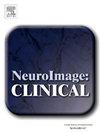Neuroimaging correlates of domain-specific cognitive deficits in amyotrophic lateral sclerosis
IF 3.6
2区 医学
Q2 NEUROIMAGING
引用次数: 0
Abstract
Background
Amyotrophic lateral sclerosis (ALS) is a fatal neurodegenerative disease with frequent extra-motor involvement. In the present study, we investigated whether specific cognitive and behavioral deficits in ALS correlate with distinct extra-motor neurodegeneration patterns on brain MRI.
Methods
We performed multimodal brain MRI and Edinburgh cognitive and behavioral ALS screen (ECAS) in 293 patients and 237 controls. Follow-up data were acquired from 171 patients with a median duration of 7.9 months. Domain-level cognitive scores from the ECAS were compared with grey and white matter MRI parameters. Interaction analyses between patients and controls were performed to explore whether correlates were specific to ALS, rather than related to normal aging. Follow-up data were used to assess changes of domain-associated brain structures over time.
Results
Language impairment was significantly associated with (left predominant) frontal, temporal, parietal and subcortical grey matter neurodegeneration. Letter fluency with widespread cortical and subcortical grey matter involvement. Memory dysfunction with hippocampal and medial-temporal atrophy. Executive impairment was exclusively correlated with widespread white matter impairment. Visuospatial scores did not correlate with MRI parameters. Interaction analyses between patients and controls showed that most ECAS-MRI correlations were stronger in ALS than in controls (75.7% significant in grey matter, 52.7% in white matter). Longitudinal analyses showed that all grey matter structures associated with cognitive domains worsened over time while, for this study population, ECAS domain scores did not decline significantly.
Conclusions
MRI can capture the heterogeneity of cognitive and behavioral involvement in ALS and provides a useful longitudinal biomarker for progression of extra-motor neurodegeneration.
肌萎缩侧索硬化症领域特异性认知缺陷的神经影像学相关性
背景肌萎缩性侧索硬化症(ALS)是一种致命的神经退行性疾病,经常累及运动外。在本研究中,我们研究了ALS的特定认知和行为缺陷是否与脑MRI上不同的运动外神经变性模式相关。方法对293例患者和237例对照组进行多模态脑MRI和爱丁堡认知与行为筛查(ECAS)。随访数据来自171例患者,中位持续时间为7.9个月。将ECAS的领域水平认知评分与灰质和白质MRI参数进行比较。对患者和对照组进行相互作用分析,以探讨相关性是否仅针对ALS,而与正常衰老无关。随访数据用于评估脑域相关结构随时间的变化。结果语言障碍与额叶、颞叶、顶叶和皮层下灰质神经退行性变(左侧占主导地位)显著相关。字母流利与广泛的皮层和皮层下灰质有关。记忆功能障碍伴海马和中颞叶萎缩。执行障碍与广泛的白质损伤完全相关。视觉空间评分与MRI参数无关。患者与对照组之间的相互作用分析显示,ALS患者的ECAS-MRI相关性强于对照组(灰质显著性为75.7%,白质显著性为52.7%)。纵向分析显示,随着时间的推移,所有与认知领域相关的灰质结构都恶化了,而在本研究人群中,ECAS领域评分并没有显著下降。结论smri可以捕捉ALS患者认知和行为的异质性,为运动外神经退行性变的进展提供了一种有用的纵向生物标志物。
本文章由计算机程序翻译,如有差异,请以英文原文为准。
求助全文
约1分钟内获得全文
求助全文
来源期刊

Neuroimage-Clinical
NEUROIMAGING-
CiteScore
7.50
自引率
4.80%
发文量
368
审稿时长
52 days
期刊介绍:
NeuroImage: Clinical, a journal of diseases, disorders and syndromes involving the Nervous System, provides a vehicle for communicating important advances in the study of abnormal structure-function relationships of the human nervous system based on imaging.
The focus of NeuroImage: Clinical is on defining changes to the brain associated with primary neurologic and psychiatric diseases and disorders of the nervous system as well as behavioral syndromes and developmental conditions. The main criterion for judging papers is the extent of scientific advancement in the understanding of the pathophysiologic mechanisms of diseases and disorders, in identification of functional models that link clinical signs and symptoms with brain function and in the creation of image based tools applicable to a broad range of clinical needs including diagnosis, monitoring and tracking of illness, predicting therapeutic response and development of new treatments. Papers dealing with structure and function in animal models will also be considered if they reveal mechanisms that can be readily translated to human conditions.
 求助内容:
求助内容: 应助结果提醒方式:
应助结果提醒方式:


